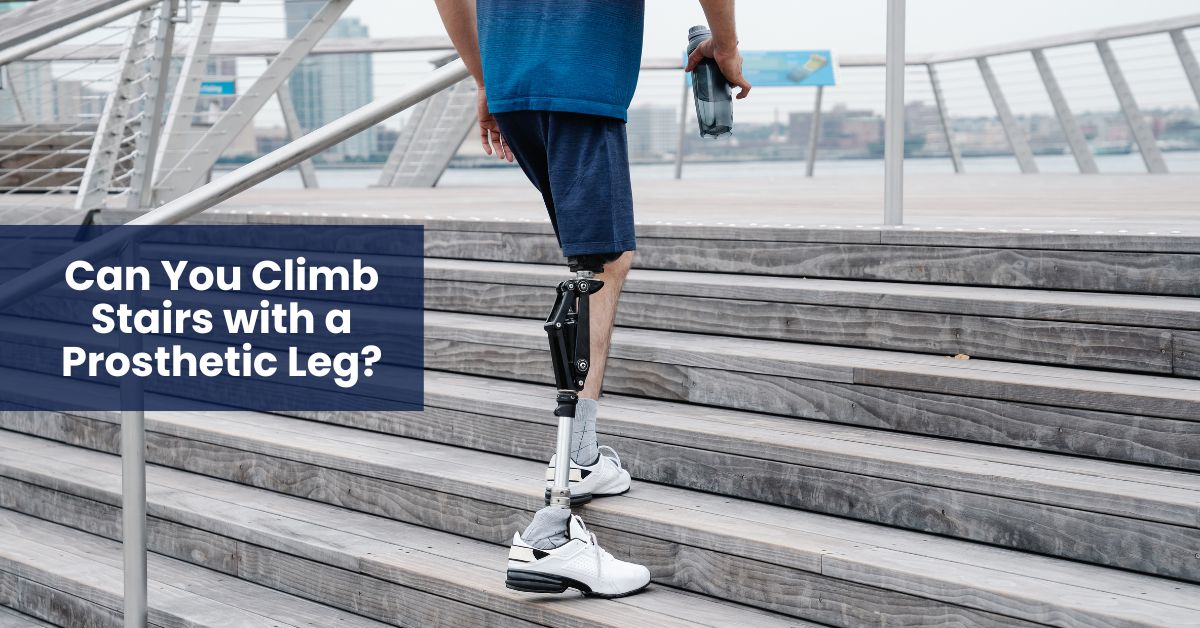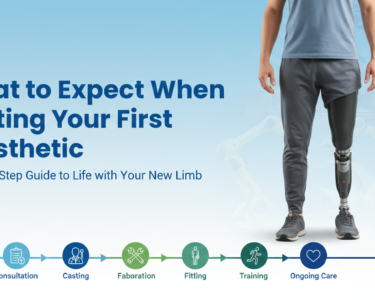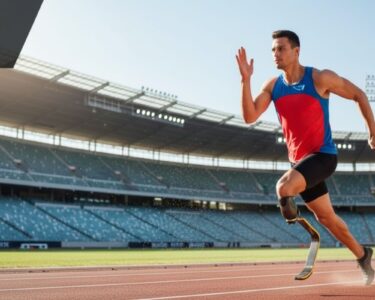“Can I climb stairs with my prosthetic leg?” — This is a very common question asked by people who are new to using an artificial leg. In daily life, stairs are everywhere—at home, in schools, offices, and even temples. So, it’s natural to worry about how you’ll manage. The good news is, yes, you can climb stairs with a prosthetic leg. With the right type of limb, a little practice, and proper support, many people learn to go up and down stairs confidently. It may take some time, but it’s definitely possible.
In the beginning, climbing stairs might feel a bit scary or uncomfortable—and that’s completely normal. Your body needs time to adjust to the new limb, and your mind needs time to build confidence. Many people start by learning with support, like using a railing or someone’s help. Physiotherapists also teach safe and easy ways to climb one step at a time. Slowly, with daily practice, most users are able to climb stairs without fear. Just remember, patience and regular training are key.
Is It Possible to Climb Stairs with a Prosthesis?
Yes, it is definitely possible to climb stairs with a prosthetic leg, and many people in India and across the world do it every day. However, how easy or difficult it feels can depend on a few things. For example, someone with a below-knee amputation may find it a bit easier compared to someone with an above-knee amputation, since bending the knee makes movement smoother. The kind of prosthetic leg you’re using also matters—some are specially designed to handle stair climbing better than others.
Physical therapy plays a big role too. If you’ve received proper training and support from a physiotherapist, you’re likely to feel more confident and stable while using stairs. Along with that, your own body strength, balance, and regular practice will make a big difference over time.
Here are a few key things that affect your ability to climb stairs with a prosthesis:
- Type of amputation (below-knee is usually easier than above-knee)
- Design and function of the prosthetic leg
- Physiotherapy, training, and practice
- Personal strength, balance, and mental confidence
Climbing stairs may feel tricky in the beginning, but with the right support and mindset, it becomes just another part of your daily routine.
Below-Knee vs. Above-Knee Prosthetics: What’s the Difference?
1. Below-Knee (Transtibial) Prosthetics
Users with a below-knee amputation retain their natural knee joint. This makes stair climbing easier. With practice, many can use a normal walking pattern (step-over-step) while climbing stairs.
2. Above-Knee (Transfemoral) Prosthetics
Above-knee prosthetic users rely on an artificial knee joint. Basic mechanical knees may make it difficult to climb stairs smoothly. However, advanced microprocessor-controlled knees help mimic natural movement, making stairs more manageable.
Tips for Climbing Stairs with a Prosthetic Leg
When you’re learning to climb stairs with a prosthetic leg, it’s best to take things slowly and carefully. Always use a handrail if there’s one nearby—it gives extra support and helps with balance. Don’t rush; give yourself time to adjust, especially in the beginning. Start by practising on small steps or one or two stairs before moving on to a full staircase.
Wearing properly fitted shoes with a good grip can make a big difference in how steady you feel while climbing. If at any point you feel wobbly or unsure while going up or down the stairs, it’s a good idea to let your prosthetist or physiotherapist know. They can check the fit of your limb or suggest changes to improve your stability and comfort. With patience and regular practice, climbing stairs can become just another part of your day.
Two Common Stair Climbing Techniques for Prosthetic Users
Climbing stairs with a prosthetic leg is possible, and people usually follow one of two common methods—depending on their confidence, strength, and the type of prosthesis they use.
1. Step-to-Step Method (Best for Beginners)
This is the easier and safer option, especially for those who are still getting used to their prosthetic leg. Here’s how it works:
- First, step up with your healthy (sound) leg
- Then, bring your prosthetic leg to the same step
- Repeat this one step at a time
This method gives you more control and balance. It’s ideal if you’re just starting out or still building strength.
2. Step-Over-Step Method (For Experienced Users)
Once you become more confident and gain better balance, you might try the step-over-step method. This is more like how people with both natural legs climb stairs—using alternate legs for each step.
- You step with one leg, then the other on the next step
- It needs good muscle control and balance
- It usually works better with advanced prosthetic legs
This method can take time and practice. Many users reach this stage after weeks or even months of physiotherapy. So don’t worry if you’re not there yet—everyone improves at their own pace.
Importance of Rehabilitation and Physical Therapy
Rehabilitation plays a very important role after getting a prosthetic leg. Just like learning anything new, your body also needs time and training to adjust. Physical therapy helps you build the strength and confidence needed to walk smoothly and climb stairs without fear. It improves your balance, coordination, and overall movement.
A trained physiotherapist will guide you step by step. They’ll teach you how to use your prosthesis correctly, avoid injuries, and develop the right posture while climbing stairs or walking on uneven surfaces. This support is especially helpful in the early weeks when you’re still getting used to the new leg.
With regular therapy and practice, most people find that everyday activities—including stairs—become easier over time.
Can You Go Downstairs with a Prosthetic Leg?
Yes, going downstairs with a prosthetic leg is possible, but it’s usually a bit more challenging than climbing up. This is because while coming down, your body must control the movement and balance your weight more carefully. For many new prosthetic users, this can feel scary at first.
Most people start with the step-to-step method, where you place your healthy leg on the step first and then bring the prosthetic leg down to the same level. This method is slower but much safer, especially when you’re still gaining confidence or strength.
As you get stronger and more comfortable, some people—especially those using advanced above-knee prostheses with microprocessor knees—may be able to use the step-over-step method while going down. This feels more natural and similar to how you may have climbed stairs before amputation. But this requires good balance, strong muscles, and regular physiotherapy.
No matter which method you use, safety should always come first. Always use a handrail if available and never rush while going downstairs. If something feels off or you feel unsteady, stop and take a moment. It’s okay to take your time—confidence grows with practice. And if you’re unsure about your technique, speak with your prosthetist or physiotherapist—they can guide you on the best and safest way to navigate stairs based on your prosthetic limb and ability.
How Long Will It Take To Climb Stairs After Getting A Prosthetic Leg?
Learning to climb stairs with a prosthetic leg takes time and practice, but everyone’s journey is different. For some, it might take a few weeks, while for others, a few months. It depends on your strength, balance, the type of prosthesis, and how often you do physical therapy. The key is to be patient with yourself and keep practicing regularly. With the right guidance from your physiotherapist, you’ll get there step by step.
Can Above-Knee Amputees Climb Stairs With A Prosthesis?
Yes, above-knee amputees can climb stairs with a prosthetic leg, but it usually takes more effort and practice compared to below-knee amputees. Since the knee joint is missing, the prosthetic needs to include an artificial knee that can bend and support your weight safely. Modern prosthetic knees come with different levels of technology—from basic mechanical joints to advanced microprocessor-controlled knees—that help users move more naturally while climbing stairs.
However, climbing stairs with an above-knee prosthesis requires good balance, strength, and training. Physical therapy plays a big role in helping you learn how to use the artificial knee and coordinate your movements. At first, it might feel challenging, but with time, patience, and proper support, many above-knee amputees regain the ability to climb stairs confidently and safely in their daily lives.
What Should I Do If I Feel Unsteady While Climbing Stairs?
Feeling unsteady while climbing stairs with a prosthetic leg is common, especially when you’re still learning. If this happens, the first thing to do is slow down and hold onto the handrail or any support nearby. Don’t rush—take your time with each step to keep your balance. It’s okay to pause and steady yourself whenever needed.
If unsteadiness continues, talk to your prosthetist or physical therapist. They can check if your prosthetic fits well and is working properly. Sometimes, small adjustments or extra training can make a big difference. Remember, safety comes first, so don’t be afraid to ask for help or use support until you feel more confident.
You Can Do It — Step by Step Toward a Confident Life
Climbing stairs with a prosthetic leg is definitely possible, though it may take time, practice, and the right kind of prosthesis. Whether you are an above-knee or below-knee amputee, regaining this everyday skill depends on your strength, balance, and the type of artificial limb you use. Starting slowly, using handrails, and working closely with your physiotherapist can make the process safer and easier. There are different stair-climbing methods, each suited to different levels of ability and prosthetic technology. Remember, feeling unsteady is normal at first—taking precautions and seeking help will help you build confidence and independence step by step. With patience and proper support, climbing stairs can become a smooth part of your daily routine again.
Disclaimer:
The information provided in this article is for general awareness and educational purposes only. Readers are advised to consult certified prosthetists, medical professionals, or insurance advisors for personalized advice and the most accurate, up-to-date details before making any healthcare decisions.








